Revised Framework of Fair Value Measurement under IFRS 13
VerifiedAdded on 2020/04/01
|7
|1204
|78
AI Summary
The paper examines how IFRS 13 introduces a structured framework to enhance fair value measurement consistency in financial reporting. It outlines the hierarchy of valuation inputs from observable market prices to unobservable estimates and discusses underlying assumptions such as risk considerations and market participant perspectives. The paper also evaluates the impact of these changes on transparency and efficiency in accounting practices, emphasizing their importance for accurate asset and liability assessment.

Running head: ADVANCE FINANCIAL ACCOUNTING
ADVANCE FINANCIAL ACCOUNTING
Name of Student:
Name of University:
Author Note:
ADVANCE FINANCIAL ACCOUNTING
Name of Student:
Name of University:
Author Note:
Paraphrase This Document
Need a fresh take? Get an instant paraphrase of this document with our AI Paraphraser
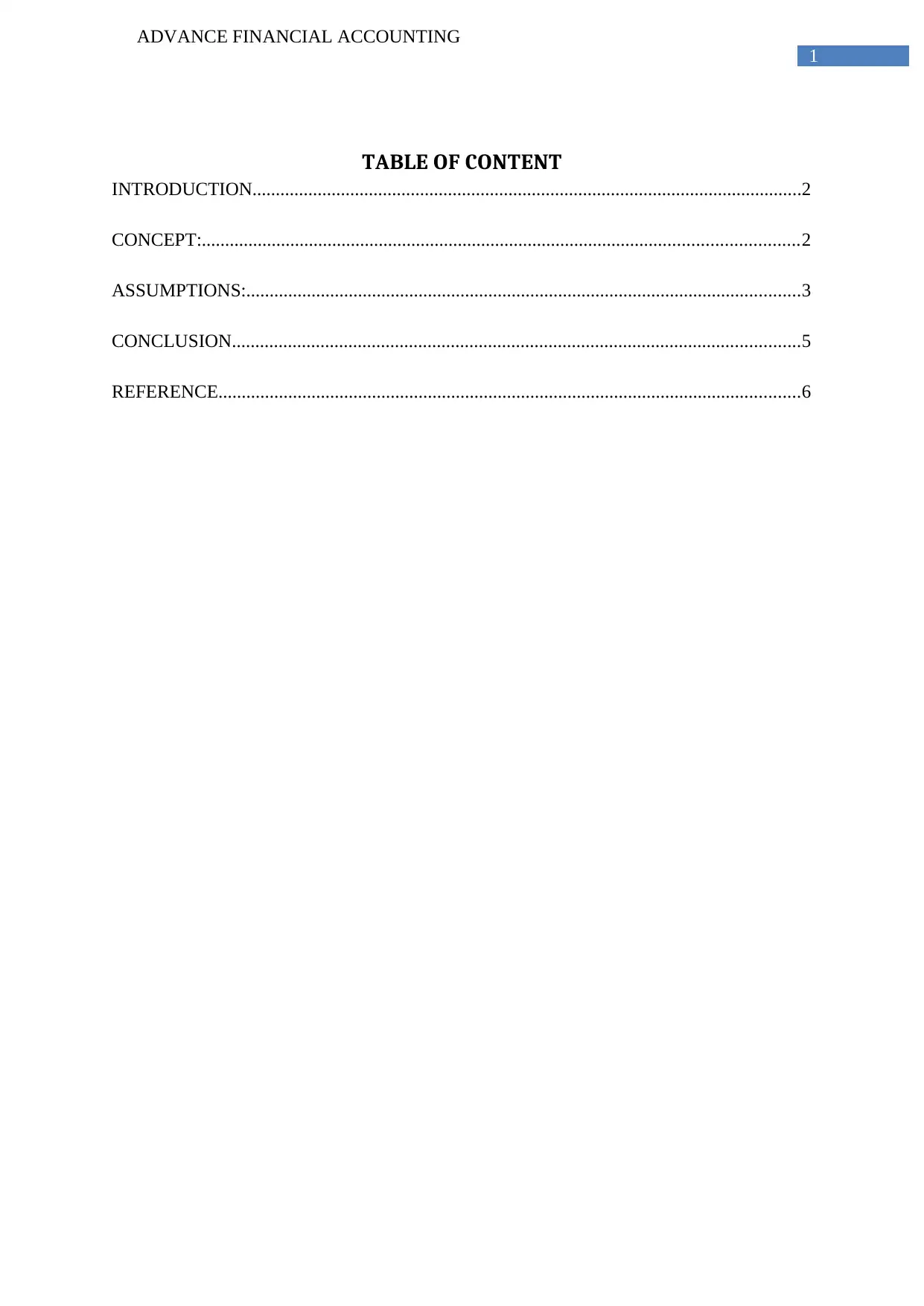
1
ADVANCE FINANCIAL ACCOUNTING
TABLE OF CONTENT
INTRODUCTION......................................................................................................................2
CONCEPT:................................................................................................................................2
ASSUMPTIONS:.......................................................................................................................3
CONCLUSION..........................................................................................................................5
REFERENCE.............................................................................................................................6
ADVANCE FINANCIAL ACCOUNTING
TABLE OF CONTENT
INTRODUCTION......................................................................................................................2
CONCEPT:................................................................................................................................2
ASSUMPTIONS:.......................................................................................................................3
CONCLUSION..........................................................................................................................5
REFERENCE.............................................................................................................................6
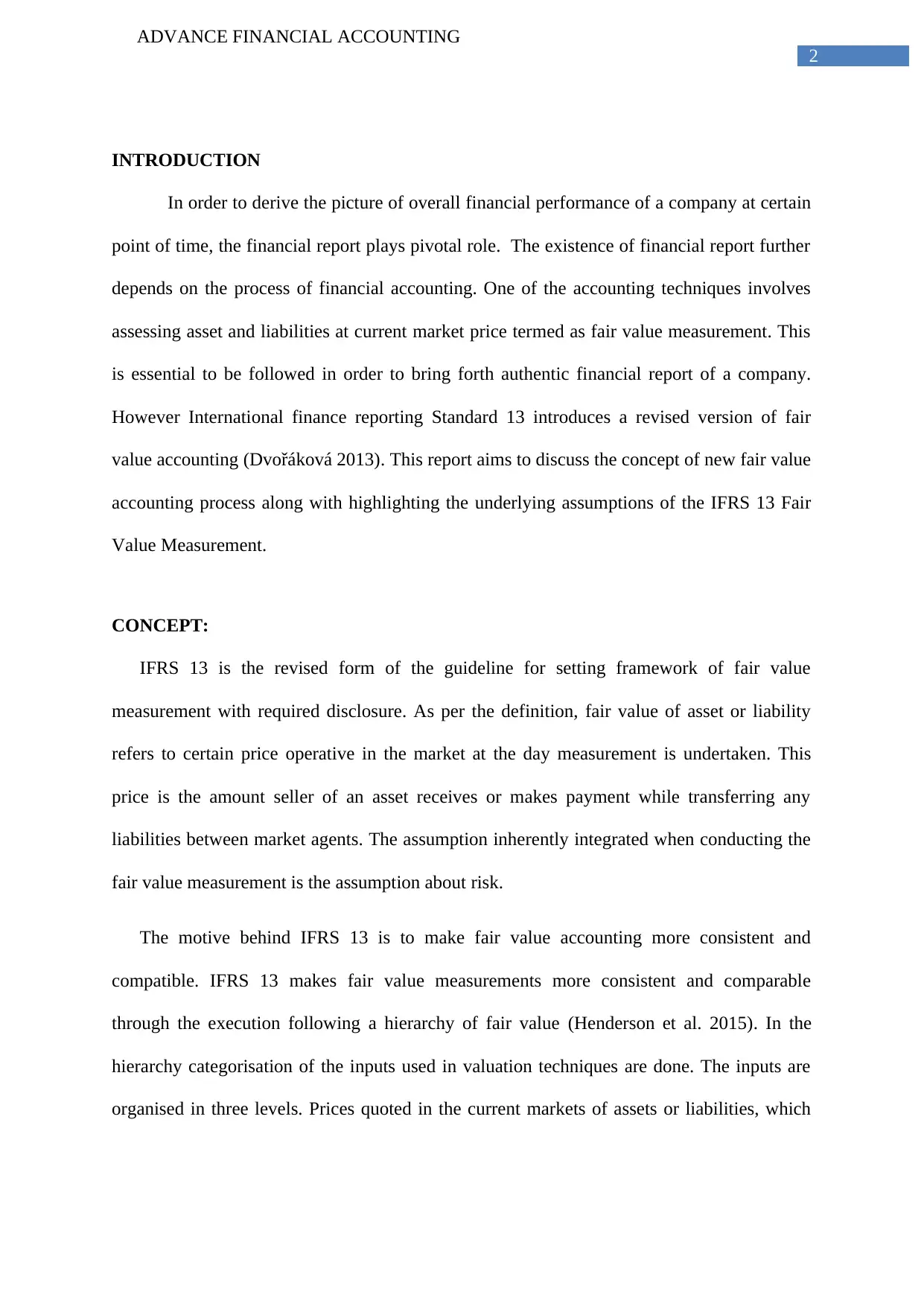
2
ADVANCE FINANCIAL ACCOUNTING
INTRODUCTION
In order to derive the picture of overall financial performance of a company at certain
point of time, the financial report plays pivotal role. The existence of financial report further
depends on the process of financial accounting. One of the accounting techniques involves
assessing asset and liabilities at current market price termed as fair value measurement. This
is essential to be followed in order to bring forth authentic financial report of a company.
However International finance reporting Standard 13 introduces a revised version of fair
value accounting (Dvořáková 2013). This report aims to discuss the concept of new fair value
accounting process along with highlighting the underlying assumptions of the IFRS 13 Fair
Value Measurement.
CONCEPT:
IFRS 13 is the revised form of the guideline for setting framework of fair value
measurement with required disclosure. As per the definition, fair value of asset or liability
refers to certain price operative in the market at the day measurement is undertaken. This
price is the amount seller of an asset receives or makes payment while transferring any
liabilities between market agents. The assumption inherently integrated when conducting the
fair value measurement is the assumption about risk.
The motive behind IFRS 13 is to make fair value accounting more consistent and
compatible. IFRS 13 makes fair value measurements more consistent and comparable
through the execution following a hierarchy of fair value (Henderson et al. 2015). In the
hierarchy categorisation of the inputs used in valuation techniques are done. The inputs are
organised in three levels. Prices quoted in the current markets of assets or liabilities, which
ADVANCE FINANCIAL ACCOUNTING
INTRODUCTION
In order to derive the picture of overall financial performance of a company at certain
point of time, the financial report plays pivotal role. The existence of financial report further
depends on the process of financial accounting. One of the accounting techniques involves
assessing asset and liabilities at current market price termed as fair value measurement. This
is essential to be followed in order to bring forth authentic financial report of a company.
However International finance reporting Standard 13 introduces a revised version of fair
value accounting (Dvořáková 2013). This report aims to discuss the concept of new fair value
accounting process along with highlighting the underlying assumptions of the IFRS 13 Fair
Value Measurement.
CONCEPT:
IFRS 13 is the revised form of the guideline for setting framework of fair value
measurement with required disclosure. As per the definition, fair value of asset or liability
refers to certain price operative in the market at the day measurement is undertaken. This
price is the amount seller of an asset receives or makes payment while transferring any
liabilities between market agents. The assumption inherently integrated when conducting the
fair value measurement is the assumption about risk.
The motive behind IFRS 13 is to make fair value accounting more consistent and
compatible. IFRS 13 makes fair value measurements more consistent and comparable
through the execution following a hierarchy of fair value (Henderson et al. 2015). In the
hierarchy categorisation of the inputs used in valuation techniques are done. The inputs are
organised in three levels. Prices quoted in the current markets of assets or liabilities, which
⊘ This is a preview!⊘
Do you want full access?
Subscribe today to unlock all pages.

Trusted by 1+ million students worldwide
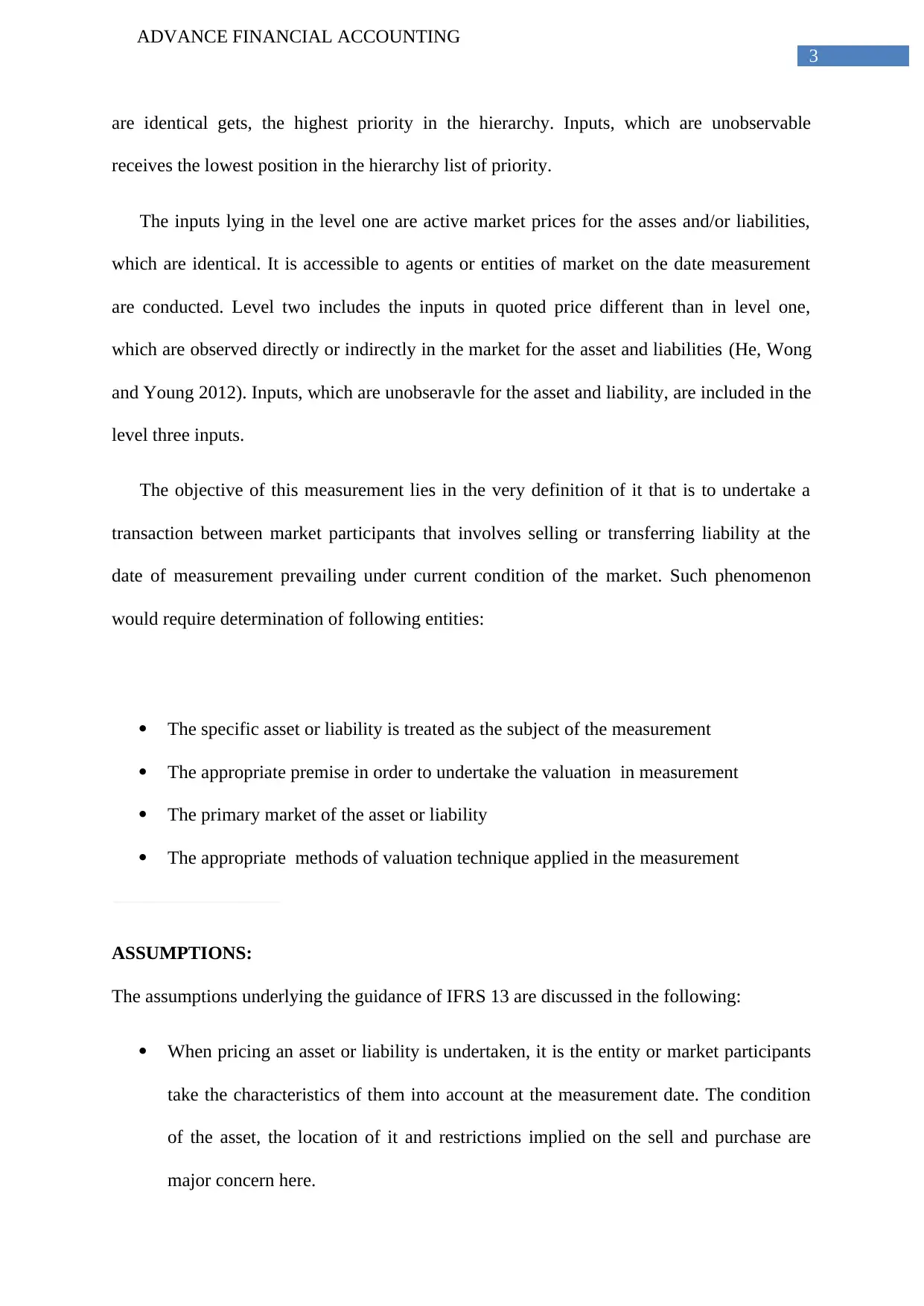
3
ADVANCE FINANCIAL ACCOUNTING
are identical gets, the highest priority in the hierarchy. Inputs, which are unobservable
receives the lowest position in the hierarchy list of priority.
The inputs lying in the level one are active market prices for the asses and/or liabilities,
which are identical. It is accessible to agents or entities of market on the date measurement
are conducted. Level two includes the inputs in quoted price different than in level one,
which are observed directly or indirectly in the market for the asset and liabilities (He, Wong
and Young 2012). Inputs, which are unobseravle for the asset and liability, are included in the
level three inputs.
The objective of this measurement lies in the very definition of it that is to undertake a
transaction between market participants that involves selling or transferring liability at the
date of measurement prevailing under current condition of the market. Such phenomenon
would require determination of following entities:
The specific asset or liability is treated as the subject of the measurement
The appropriate premise in order to undertake the valuation in measurement
The primary market of the asset or liability
The appropriate methods of valuation technique applied in the measurement
Level 1 inputs are quoted prices in active markets for identical assets or liabilities that the entity can access at the measurement date. Level 1 inputs are quoted prices in active markets for identical assets or liabilities that the entity can access at te.
ASSUMPTIONS:
The assumptions underlying the guidance of IFRS 13 are discussed in the following:
When pricing an asset or liability is undertaken, it is the entity or market participants
take the characteristics of them into account at the measurement date. The condition
of the asset, the location of it and restrictions implied on the sell and purchase are
major concern here.
ADVANCE FINANCIAL ACCOUNTING
are identical gets, the highest priority in the hierarchy. Inputs, which are unobservable
receives the lowest position in the hierarchy list of priority.
The inputs lying in the level one are active market prices for the asses and/or liabilities,
which are identical. It is accessible to agents or entities of market on the date measurement
are conducted. Level two includes the inputs in quoted price different than in level one,
which are observed directly or indirectly in the market for the asset and liabilities (He, Wong
and Young 2012). Inputs, which are unobseravle for the asset and liability, are included in the
level three inputs.
The objective of this measurement lies in the very definition of it that is to undertake a
transaction between market participants that involves selling or transferring liability at the
date of measurement prevailing under current condition of the market. Such phenomenon
would require determination of following entities:
The specific asset or liability is treated as the subject of the measurement
The appropriate premise in order to undertake the valuation in measurement
The primary market of the asset or liability
The appropriate methods of valuation technique applied in the measurement
Level 1 inputs are quoted prices in active markets for identical assets or liabilities that the entity can access at the measurement date. Level 1 inputs are quoted prices in active markets for identical assets or liabilities that the entity can access at te.
ASSUMPTIONS:
The assumptions underlying the guidance of IFRS 13 are discussed in the following:
When pricing an asset or liability is undertaken, it is the entity or market participants
take the characteristics of them into account at the measurement date. The condition
of the asset, the location of it and restrictions implied on the sell and purchase are
major concern here.
Paraphrase This Document
Need a fresh take? Get an instant paraphrase of this document with our AI Paraphraser
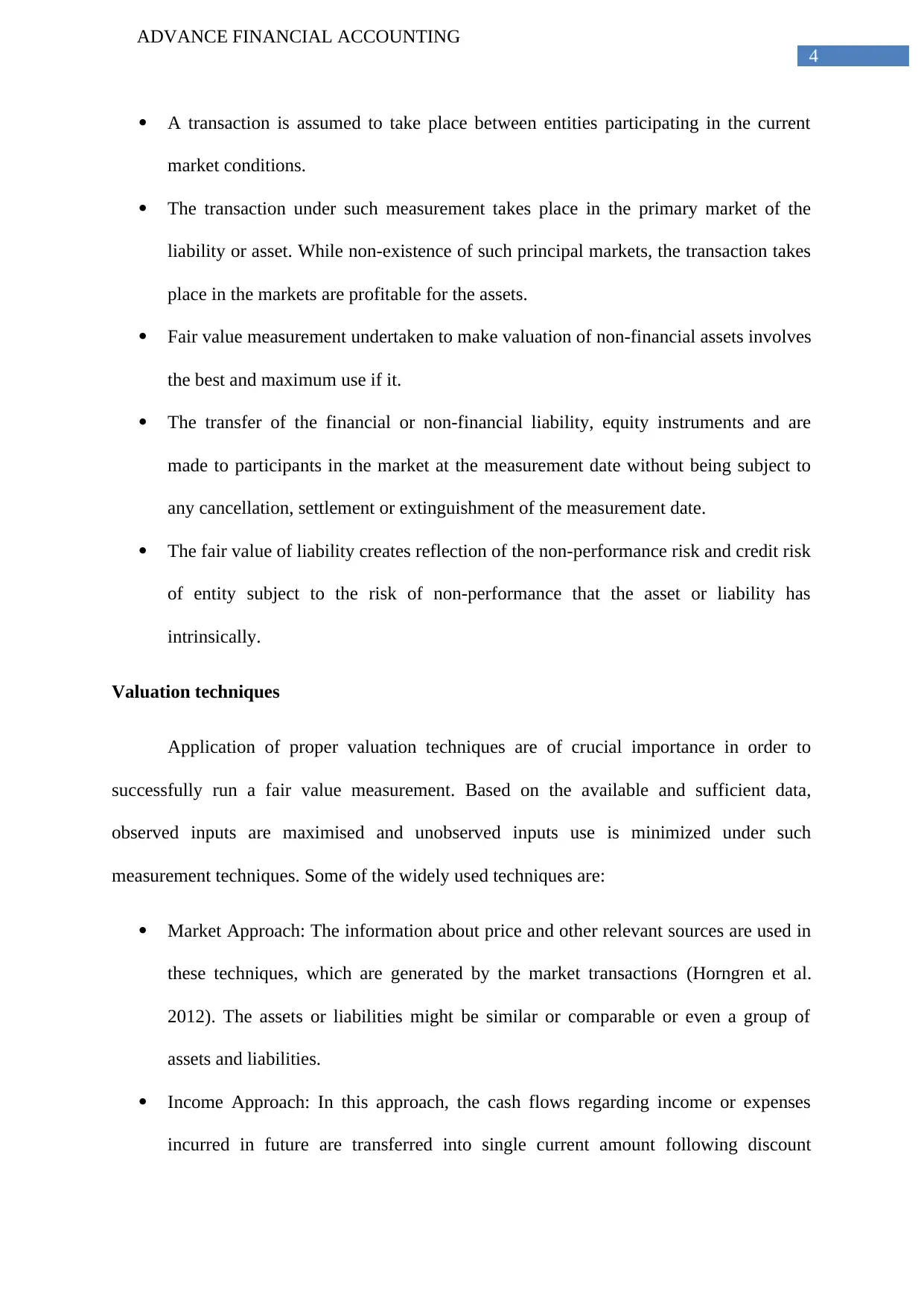
4
ADVANCE FINANCIAL ACCOUNTING
A transaction is assumed to take place between entities participating in the current
market conditions.
The transaction under such measurement takes place in the primary market of the
liability or asset. While non-existence of such principal markets, the transaction takes
place in the markets are profitable for the assets.
Fair value measurement undertaken to make valuation of non-financial assets involves
the best and maximum use if it.
The transfer of the financial or non-financial liability, equity instruments and are
made to participants in the market at the measurement date without being subject to
any cancellation, settlement or extinguishment of the measurement date.
The fair value of liability creates reflection of the non-performance risk and credit risk
of entity subject to the risk of non-performance that the asset or liability has
intrinsically.
Valuation techniques
Application of proper valuation techniques are of crucial importance in order to
successfully run a fair value measurement. Based on the available and sufficient data,
observed inputs are maximised and unobserved inputs use is minimized under such
measurement techniques. Some of the widely used techniques are:
Market Approach: The information about price and other relevant sources are used in
these techniques, which are generated by the market transactions (Horngren et al.
2012). The assets or liabilities might be similar or comparable or even a group of
assets and liabilities.
Income Approach: In this approach, the cash flows regarding income or expenses
incurred in future are transferred into single current amount following discount
ADVANCE FINANCIAL ACCOUNTING
A transaction is assumed to take place between entities participating in the current
market conditions.
The transaction under such measurement takes place in the primary market of the
liability or asset. While non-existence of such principal markets, the transaction takes
place in the markets are profitable for the assets.
Fair value measurement undertaken to make valuation of non-financial assets involves
the best and maximum use if it.
The transfer of the financial or non-financial liability, equity instruments and are
made to participants in the market at the measurement date without being subject to
any cancellation, settlement or extinguishment of the measurement date.
The fair value of liability creates reflection of the non-performance risk and credit risk
of entity subject to the risk of non-performance that the asset or liability has
intrinsically.
Valuation techniques
Application of proper valuation techniques are of crucial importance in order to
successfully run a fair value measurement. Based on the available and sufficient data,
observed inputs are maximised and unobserved inputs use is minimized under such
measurement techniques. Some of the widely used techniques are:
Market Approach: The information about price and other relevant sources are used in
these techniques, which are generated by the market transactions (Horngren et al.
2012). The assets or liabilities might be similar or comparable or even a group of
assets and liabilities.
Income Approach: In this approach, the cash flows regarding income or expenses
incurred in future are transferred into single current amount following discount
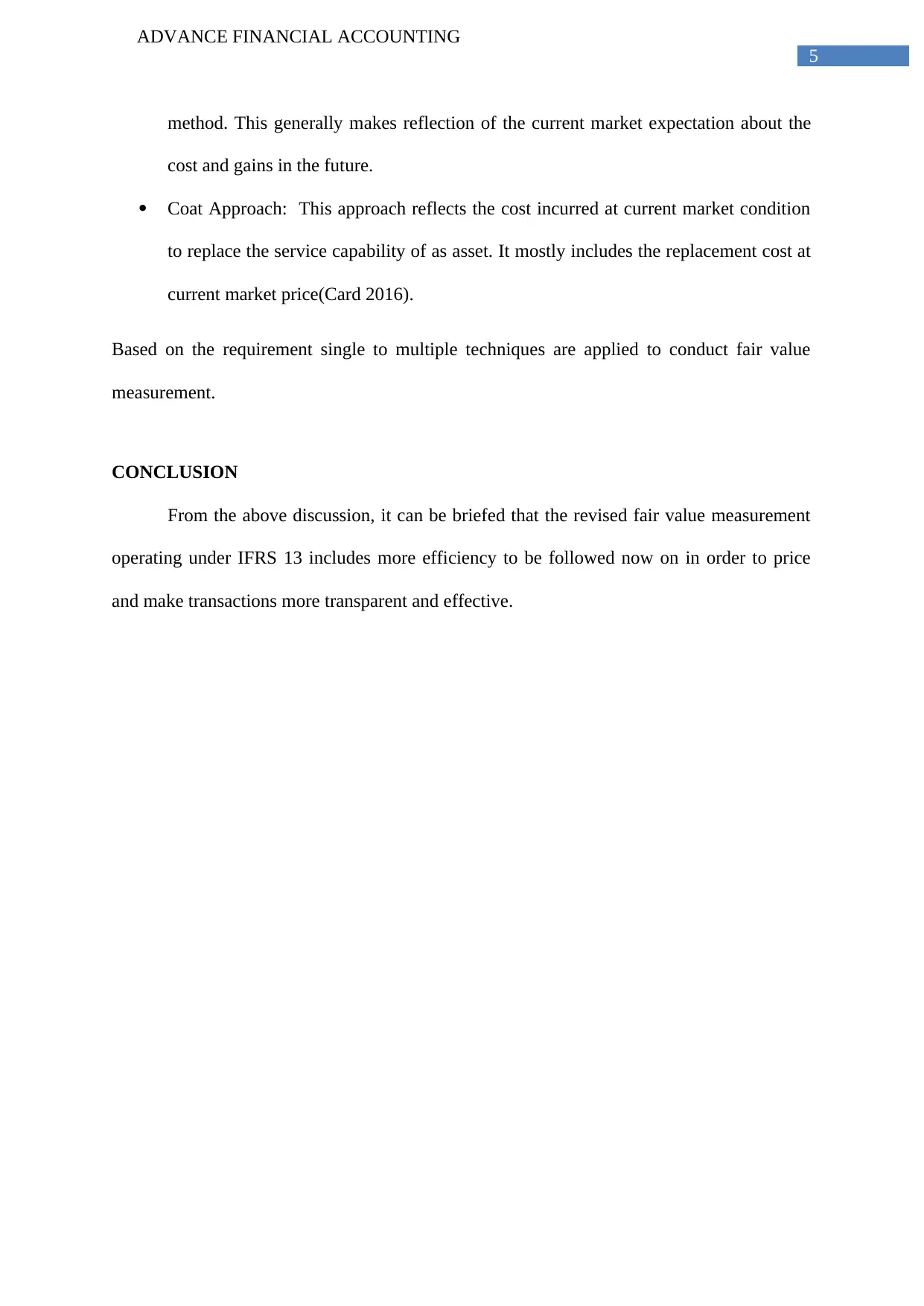
5
ADVANCE FINANCIAL ACCOUNTING
method. This generally makes reflection of the current market expectation about the
cost and gains in the future.
Coat Approach: This approach reflects the cost incurred at current market condition
to replace the service capability of as asset. It mostly includes the replacement cost at
current market price(Card 2016).
Based on the requirement single to multiple techniques are applied to conduct fair value
measurement.
CONCLUSION
From the above discussion, it can be briefed that the revised fair value measurement
operating under IFRS 13 includes more efficiency to be followed now on in order to price
and make transactions more transparent and effective.
ADVANCE FINANCIAL ACCOUNTING
method. This generally makes reflection of the current market expectation about the
cost and gains in the future.
Coat Approach: This approach reflects the cost incurred at current market condition
to replace the service capability of as asset. It mostly includes the replacement cost at
current market price(Card 2016).
Based on the requirement single to multiple techniques are applied to conduct fair value
measurement.
CONCLUSION
From the above discussion, it can be briefed that the revised fair value measurement
operating under IFRS 13 includes more efficiency to be followed now on in order to price
and make transactions more transparent and effective.
⊘ This is a preview!⊘
Do you want full access?
Subscribe today to unlock all pages.

Trusted by 1+ million students worldwide

6
ADVANCE FINANCIAL ACCOUNTING
REFERENCE
Card, C., 2016. Fair Value Accounting.
Christensen, H.B. and Nikolaev, V.V., 2013. Does fair value accounting for non-financial
assets pass the market test?. Review of Accounting Studies, 18(3), pp.734-775.
Dvořáková, D.A.N.A., 2013. Developments in fair value measurement: some IFRS 13
view. Recent researches in applied economics, pp.151-156.
He, X., Wong, T.J. and Young, D., 2012. Challenges for implementation of fair value
accounting in emerging markets: Evidence from China. Contemporary Accounting
Research, 29(2), pp.538-562.
Henderson, S., Peirson, G., Herbohn, K. and Howieson, B., 2015. Issues in financial
accounting. Pearson Higher Education AU.
Horngren, C., Harrison, W., Oliver, S., Best, P., Fraser, D. and Tan, R., 2012. Financial
accounting. Pearson Higher Education AU.
ADVANCE FINANCIAL ACCOUNTING
REFERENCE
Card, C., 2016. Fair Value Accounting.
Christensen, H.B. and Nikolaev, V.V., 2013. Does fair value accounting for non-financial
assets pass the market test?. Review of Accounting Studies, 18(3), pp.734-775.
Dvořáková, D.A.N.A., 2013. Developments in fair value measurement: some IFRS 13
view. Recent researches in applied economics, pp.151-156.
He, X., Wong, T.J. and Young, D., 2012. Challenges for implementation of fair value
accounting in emerging markets: Evidence from China. Contemporary Accounting
Research, 29(2), pp.538-562.
Henderson, S., Peirson, G., Herbohn, K. and Howieson, B., 2015. Issues in financial
accounting. Pearson Higher Education AU.
Horngren, C., Harrison, W., Oliver, S., Best, P., Fraser, D. and Tan, R., 2012. Financial
accounting. Pearson Higher Education AU.
1 out of 7
Related Documents
Your All-in-One AI-Powered Toolkit for Academic Success.
+13062052269
info@desklib.com
Available 24*7 on WhatsApp / Email
![[object Object]](/_next/static/media/star-bottom.7253800d.svg)
Unlock your academic potential
Copyright © 2020–2025 A2Z Services. All Rights Reserved. Developed and managed by ZUCOL.





